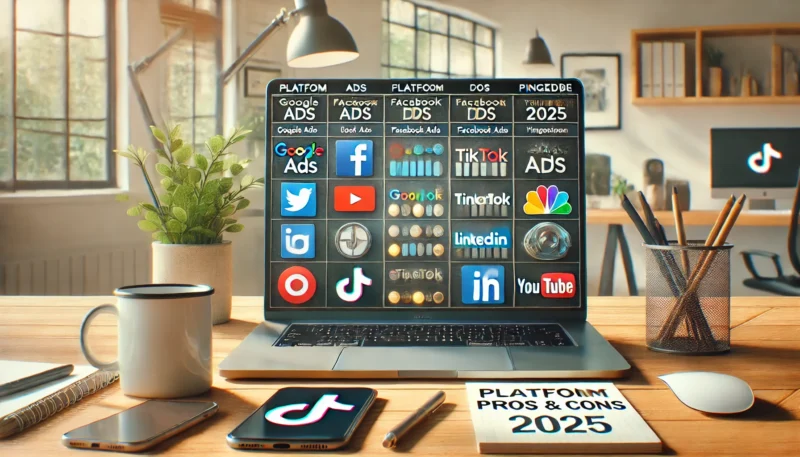Choosing the right platform for your paid advertising campaigns can make or break your results. With so many options — from Google and Meta to TikTok, LinkedIn, and emerging platforms — it’s easy to feel overwhelmed.
In this guide, we’ll break down the best paid ad platforms in 2025, compare their strengths and weaknesses, and help you choose the one that fits your goals, audience, and budget.
1. Google Ads
Best For:
-
High-intent search traffic
-
Local services
-
eCommerce
-
SaaS and lead generation
Key Formats:
-
Search ads
-
Display Network
-
YouTube ads
-
Performance Max
-
Shopping ads
Pros:
-
Intent-based targeting (people are actively searching)
-
Massive reach across Google ecosystem
-
Powerful tools for tracking and optimization
-
High conversion potential for transactional queries
Cons:
-
Can be expensive in competitive niches
-
Learning curve for beginners
-
Requires ongoing optimization and keyword research
2. Meta Ads (Facebook & Instagram)
Best For:
-
Brand awareness
-
Retargeting
-
eCommerce and info products
-
Storytelling and lead magnets
Key Formats:
-
Image, video, carousel, collection
-
Reels and Stories
-
Lead forms and Messenger ads
Pros:
-
Extremely detailed audience targeting
-
Visual, engaging ad formats
-
Great for building full-funnel campaigns
-
Strong retargeting capabilities
Cons:
-
Privacy updates (like iOS14+) have affected tracking
-
Ad fatigue happens quickly
-
Lower buyer intent than search-based platforms
3. YouTube Ads
Best For:
-
Brand storytelling
-
Product demos
-
Course launches
-
Retargeting audiences
Key Formats:
-
Skippable in-stream ads
-
Non-skippable ads
-
Bumper ads
-
Discovery and Shorts ads
Pros:
-
Huge reach and affordable impressions
-
Strong engagement for video-first offers
-
Great for building authority and trust
Cons:
-
Requires video production (or UGC strategy)
-
View-through conversions can be harder to track
-
Lower conversion rates compared to search
4. TikTok Ads
Best For:
-
Viral consumer products
-
Gen Z and Millennial audiences
-
Mobile-first brands
-
Short-form content creators
Key Formats:
-
In-feed video ads
-
Spark Ads (boosted UGC)
-
TopView and branded effects
Pros:
-
Low CPMs and high engagement
-
Great for going viral with the right creative
-
Strong eCommerce integrations (Shopify, etc.)
Cons:
-
Short attention span = tough to convert
-
Creative fatigue happens quickly
-
Requires native, trend-driven content
5. LinkedIn Ads
Best For:
-
B2B lead generation
-
SaaS companies
-
Hiring campaigns
-
High-ticket offers and services
Key Formats:
-
Sponsored content
-
Message ads (InMail)
-
Lead gen forms
-
Conversation ads
Pros:
-
The best B2B targeting options
-
Professional, job-based filters (company size, industry, title)
-
High lead quality for certain verticals
Cons:
-
Expensive CPCs (often $5–$20+)
-
Smaller overall audience
-
Not ideal for impulse purchases
6. Pinterest Ads
Best For:
-
DIY, home, fashion, beauty, food, parenting
-
Evergreen content
-
Visual-based eCommerce
Key Formats:
-
Promoted pins
-
Shopping ads
-
Idea pins
Pros:
-
Visual search + discovery platform
-
Longer content lifecycle than social media
-
Great for driving traffic to blogs and product pages
Cons:
-
Slower conversion cycle
-
Not ideal for B2B or service-based offers
-
Requires creative tailored to platform style
7. Twitter/X Ads
Best For:
-
News, trending content
-
Tech, crypto, and finance audiences
-
Brand visibility and engagement
Key Formats:
-
Promoted tweets
-
Video views
-
Followers and engagement campaigns
Pros:
-
Real-time targeting (hashtags, keywords)
-
Lower CPMs
-
Great for community-building and awareness
Cons:
-
Limited conversion tools
-
Volatile platform (brand safety concerns)
-
Less visual — not ideal for product ads
8. Reddit Ads
Best For:
-
Niche communities
-
Tech, gaming, investing, and DIY audiences
-
Long-form content and product discussions
Pros:
-
Hyper-targeted by subreddit interest
-
Lower competition
-
Great for building thought leadership
Cons:
-
Can be hostile to overt ads
-
Requires transparency and native content
-
Not ideal for beginners or broad offers
Comparison Table (2025 Snapshot)
| Platform | Strengths | Weaknesses | Ideal For |
|---|---|---|---|
| Google Ads | High intent, huge reach | Expensive, complex | Search-driven conversions |
| Meta Ads | Visual, retargeting | Ad fatigue, privacy limits | eCommerce, storytelling |
| YouTube Ads | Video authority, cheap views | Lower CVR, creative needed | Brand building, product demos |
| TikTok Ads | Viral reach, low CPMs | Low attention span | Gen Z products, mobile offers |
| LinkedIn Ads | Elite B2B targeting | High CPC, slow scale | B2B lead gen, SaaS |
| Pinterest Ads | Long content shelf life | Niche-specific, slow funnel | Visual products, lifestyle |
| Twitter/X Ads | Trending, low cost | Low CVR, brand safety | Community and engagement |
| Reddit Ads | Super niche targeting | Hostile to bad ads | Thought leadership, forums |
Final Thoughts: Choose the Platform That Fits Your Funnel
Don’t pick a platform just because it’s trendy — pick it because it aligns with:
-
Your audience
-
Your budget
-
Your offer
-
Your creative strengths
-
Your funnel stage
In 2025, the best paid advertising strategy isn’t about going all-in on one platform — it’s about choosing the right tool for the job and scaling what works.

